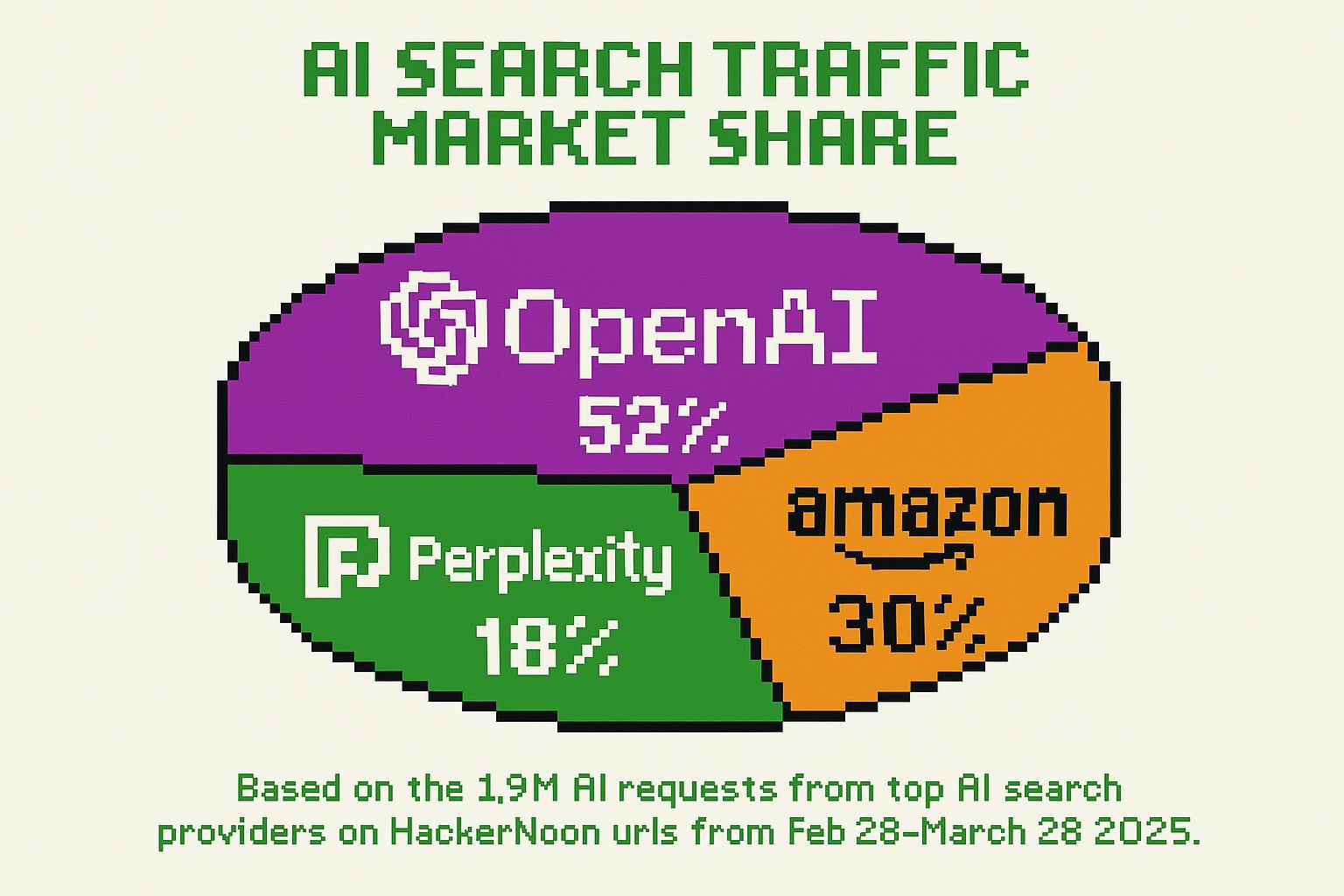OpenAI (51.8%) leads AI search traffic market share, based on my analysis of end-user–initiated AI Assistant and AI Search requests to HackerNoon. While Amazon (30.4%) and Perplexity (17.9%) also secured significant portions of the market, the total volume of requests (1,915,670 in 30 days) and competition among AI search providers indicate increasing reliance on AI for information retrieval and presentation.
This analysis aggregates AI Assistant and AI Search queries to approximate end-user–initiated AI search traffic across HackerNoon URLs. Non-human traffic such as web crawlers, bots, and automated scripts have been filtered out to ensure data reflects only human-initiated requests. The dataset reviewed comprises instances where AI systems recommended HackerNoon content in response to human queries. Between February 28 and March 28, 2025, HackerNoon received 1,915,670 AI-referred search requests. OpenAI accounted for 991,580 requests, Amazon accounted for 581,990 requests , and Perplexity accounted for 342,100 requests, according to Cloudflare AI Audit tool, which currently tracks these top providers. HackerNoon is a technical audience, so our data is better positioned to answer questions like, if you work in tech what AI search engine do you rely on?
This data provides a valuable proxy of the emerging AI search market beyond Google. Do note why I say beyond Google: as Google’s slapped AI generated results atop most search results, they are ostensively the leader in AI search market share in the same manner that they are ostensively the leader in total search market share. The migration of traditional search traffic toward AI-native interfaces is complex, resembling a Venn diagram with massively overlapping user behaviors. At the end of the day, the end user is inputting text to the internet hoping for more relevant, usable, and helpful output. Nevertheless another recent poll put OpenAI (37%) above Google (32%) when it comes to who to turn to when you need answers. Where do I personally turn to when I need answers? Linh of course I digress. Also worth noting HackerNoon uses products from all three companies mentioned here.
Let’s break down what usage means within each company. OpenAI is direct usage from ChatGPT and other third party apps using OpenAI APIs. The top apps using OpenAI APIs for assistant or search uses are (according to ChatGPT): GitHub Copilot, Microsoft 365 Office, Notion AI, Intercom, Jasper, Copy.ai, Grammarly, and Zoom. Anthropic’s Claude is the top end user app of Amazon’s requests, but Amazon’s share does also include other AI products built with Amazon APIs like Witlingo and Haptik. How could this change moving forward? On March 20th, Anthropic’s Claude started directly letting users connect to the web, so on the next version of this data review, I would guess Amazon/Anthropic is likely to gain more market share. Perplexity is direct usage from the Perplexity app and other apps using Perplexity’s APIs, such as LTV.ai. Perplexity’s developer API adoption is less than Amazon’s and OpenAI’s, indicating a higher proportion of their market share likely stems from the Perplexity app itself. Will also be keeping a close eye on how MCPs make more models, products and apps able to create AI search traffic.
After a few decades of Google dominance, the internet search market is being disrupted. Major players are jockeying for their share. OpenAI (and of course Google) currently lead the AI search pack. As companies like Amazon, Perplexity, and hopefully new players continue to innovate and expand their offerings, I anticipate more maturation and battles for attention before these companies settle into a long term term marketshare position. With millions of monthly human initiated AI search events calling the HackerNoon Library, we have rare insight into how and how often models and products like ChatGPT, Claude, and Perplexity are actually surfacing content. We’ll be updating these AI search traffic rankings periodically—so smash that subscribe button by my profile pic to see how the AI landscape evolves. In the meantime, what AI data would you find most useful for me to breakdown? Maybe what blog URLs what models and products are most often requesting? Maybe how and when do AI search requests spike? Or which AI models and products trend in which regions? Comment below. Data always has a lot to say.

